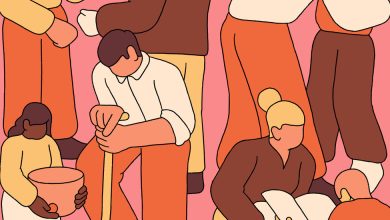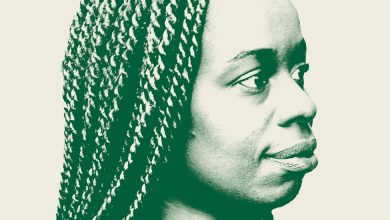Asian and Black Communities Have a Long History of Shared Solidarity

Black and Asian communities in America today are often portrayed as in conflict with each other. But we have a long history of organizing with each other, too. In the 19th and early 20th centuries, Asian Americans working as immigrant laborers in the United States were often subjected to racial violence. That experience of discrimination created solidarity with the Black community.
In 1869, Frederick Douglass spoke out against restrictions on Chinese immigration. Yuri Kochiyama, a friend and ally of Malcolm X, cradled his bleeding head when he was assassinated in 1965. Jesse Jackson took time away from his presidential bid to protest the killing of Vincent Chin in 1982. These stories of loss, struggle, change and hope are the most powerful tools we have to understand one another and bridge what divides us.

Betty Yu, artist and activist. “Our communities are paving our own way toward healing, restoration and solidarity. We understand that we, everyday Asians, have more in common with the Black community than we do differences.”
The Asian civil rights movement was inspired in part by the Black civil rights campaigns of the 1960s. It was around this time that the model minority myth emerged, portraying Asian and Pacific Islander Americans as mostly hard-working, well educated and healthy, the artist and activist Betty Yu explained. “The model minority stereotype falsely depicts Asians as a wealthy Ivy League-educated monolith while completely ignoring the economic inequalities that exist to this day,” she said.
As Americans reckon with racial injustice, police brutality and a spike in anti-Asian attacks, we have an opportunity to relearn our shared history and build on that solidarity.
I was living in Taiwan when George Floyd died after being handcuffed and pinned to the ground under a police officer’s knee. I coped by helping to coordinate the Black Lives Matter March in Taipei. It was important to me to stand up for myself and my community and close the metaphorical distance between me and my home.
In New York City, Jeanie Jay Park, the lead organizer of Warriors in the Garden, a collective of nonviolent activists and the founder of Sanitation Nation, a nonprofit youth solidarity collective, was among the thousands marching on the Brooklyn Bridge that summer when a group of young boys approached her and yelled, “Your people killed my people.” They were talking about an officer of Hmong descent who stood by while Mr. Floyd was murdered.
“I understood their reaction,” she said. She has since worked to build intersectional solidarity between Black and Asian communities. Coalition building requires having uncomfortable conversations with not just ourselves but also our families in order to dismantle generational colorism and anti-Black sentiment that exists in many Asian cultures, Ms. Park said.
Nupol Kiazolu, the founder of We Protect Us, believes that practicing love, education and patience is the key to fostering unity between Black and Asian communities. “We must be willing to listen to each other with open minds, ears and hearts,” she said.
Wendy Wang immigrated to the United States in the 1990s. She worked in restaurants around the city, until she was eventually able to open her own restaurant. She’s faced obstacles in the community — someone once shot her husband in the face with a BB gun — but over time she’s built strong relationships with the loyal customers she serves.
I come from a family of immigrants, too. My mother is from Vietnam, and my father is from Nigeria. They met and fell in love in Texas, but their families didn’t approve of their union. As a result, my siblings and I didn’t have a relationship with our extended family or with our cultures, for that matter.
Navigating a mix of identities at times felt complicated. When I’d watch my father’s interactions with law enforcement, I surmised that perhaps one part of my identity could be safer than the other. But the rise in anti-Asian violence has shattered that illusion and reminded me that the shields we hide behind can be dangerously thin.
Social media has been a powerful tool for organizing, but it can also push us into echo chambers. Chelsea Miller, a co-founder of Freedom March NYC and a social impact strategist, believes that challenging rhetorics that divide our communities is a critical step forward. “The reality is, we are all connected,” she said.
I am still striving, and struggling, to carry the weight of being both Black and Asian in this uncertain moment. I feel the push and pull of both sides, but I’m learning to lean into the liminal spaces where my intersectional identity sits. I see that there is nuance, beauty and complexity to be found in that messy middle. Belonging can happen in connections and contradictions and in bridging and breaking. Being in between can be painful but also powerful.
An Rong Xu is a photographer, filmmaker and artist. Leslie Nguyen-Okwu is a journalist and the author of the forthcoming book “American Hyphen.”
The Times is committed to publishing a diversity of letters to the editor. We’d like to hear what you think about this or any of our articles. Here are some tips. And here’s our email: [email protected].
Follow The New York Times Opinion section on Facebook, Twitter (@NYTopinion) and Instagram.





